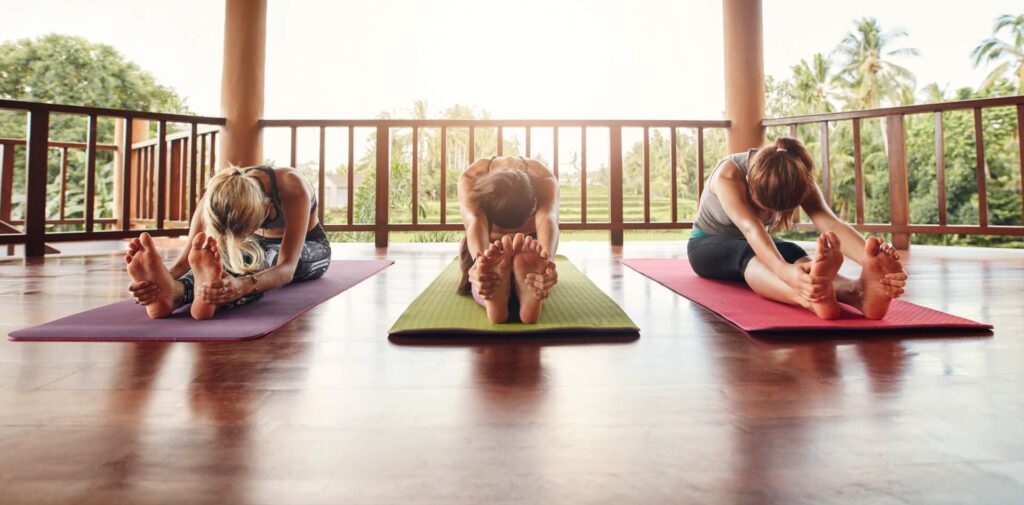“In the Seated Forward Fold, we bend to release, letting go of the past and embracing the potential of the future.”
Seated Forward Fold, also known as Paschimottanasana! Whether you’re a beginner looking to improve your flexibility or an intermediate yogi looking to deepen your practice, this pose is a fantastic addition to your routine.
Paschimottanasana Meaning
Paschimottanasana, or Seated Forward Fold, has its roots in ancient yogic traditions. The name “Paschimottanasana” is derived from the Sanskrit words “paschima,” meaning “west” or “back,” “uttana,” meaning “intense stretch,” and “asana,” meaning “pose.” This pose symbolizes the surrendering of the backside of the body, reflecting the introspection and inner journey we aim to cultivate in our practice.
Strengths and Benefits of Seated Forward Fold
Seated Forward Fold offers numerous advantages for your physical and mental well-being, making it accessible to practitioners at the beginner to intermediate level:
- Hamstring and Back Stretch: It provides an intense stretch to the hamstrings and the entire length of the spine.
- Improved Posture: The pose encourages proper alignment of the spine, aiding in better posture.
- Stress Reduction: Seated Forward Fold helps calm the mind and alleviate stress.
- Digestive Aid: Regular practice can aid digestion and relieve digestive discomfort.
- Mind-Body Connection: Many practitioners find that this pose deepens their mind-body connection, fostering a sense of inner peace.
Difficulty Level and Duration Seated Forward Fold – Paschimottanasana
Paschimottanasana, also known as the Seated Forward Fold, is a yoga pose that is suitable for both beginners and intermediate practitioners. It involves folding forward from a seated position, reaching towards your toes with your hands or grabbing onto your ankles. The difficulty level of this pose can vary depending on your flexibility and the length of your hamstrings. Beginners might find it challenging to reach their toes initially, but with regular practice, they can gradually deepen the stretch. As for the duration, it is recommended to hold the pose for 30 seconds to 1 minute, gradually increasing the time as your flexibility improves. Remember to listen to your body and not push yourself too hard to avoid any strain or injury.
How to Perform Seated Forward Fold – Paschimottanasana

Step-by-step instructions:
- Starting Position: Begin by sitting on your mat with your legs extended straight in front of you. Your feet should be flexed, and your toes pointing toward the ceiling.
- Alignment: Ensure that your spine is straight, and your shoulders are relaxed.
- Inhale and Lengthen: Inhale deeply, and as you exhale, start to hinge at your hips, leading with your chest. Keep your back straight.
- Reach Forward: Extend your arms forward, reaching for your feet, ankles, or shins. It’s crucial to keep your back straight rather than rounding it.
- Hold and Breathe: Maintain the pose for 15-30 seconds or longer, breathing deeply and gradually moving deeper into the stretch.
- Exit the Pose: To release, inhale and slowly come back to an upright seated position, keeping your back straight.
Seated Forward Fold Variations and Modifications Paschimottanasana
If you have tight hamstrings or limited flexibility, you can use a yoga strap or a towel to loop around your feet and hold onto it for added support. To reduce strain on the lower back, you can bend your knees slightly.
Preparation Poses
- Staff Pose (Dandasana): Begin your practice with Staff Pose to establish proper alignment and prepare your hamstrings.
- Half Forward Bend (Ardha Uttanasana): This preparatory pose helps loosen the hamstrings and prepare your body for the full forward bend.
Alternative Poses
- Fish Pose (Matsyasana): After Paschimottanasana, practice Fish Pose to gently arch your back in the opposite direction and stretch your chest.
- Bridge Pose (Setu Bandha Sarvangasana): Bridge Pose can help release any residual tension in the spine and hip flexors.
Yoga Music
Yoga music can greatly enhance your practice of Seated Forward Fold (Paschimottanasana) for both beginners and intermediate practitioners. The soothing melodies and rhythmic beats create a calm and focused ambiance, allowing you to dive deeper into the pose. The gentle tunes help relax the mind, release tension in the body, and promote a sense of inner peace.
Healing Crystal for Seated Forward Fold – Paschimottanasana

Crystals and gemstones are often associated with enhancing meditation and yoga practices, including poses like Seated Forward Fold (Paschimottanasana). While the effects can be subjective and may vary from person to person, here are some ways in which crystals and gemstones can potentially elevate your yoga experience to a higher level:
- Amethyst (or Lepidolite): Amethyst provides a calming and grounding influence for Paschimottanasana, while Lepidolite also offers soothing energy and balance.
- Clear Quartz (or Selenite): Clear Quartz enhances clarity and focus during your forward fold, and Selenite also supports a clear and aligned energy.
- Rose Quartz (or Green Aventurine): Rose Quartz promotes love and serenity in Paschimottanasana, and Green Aventurine encourages heart-centered alignment.
- Blue Lace Agate (or Angelite): Blue Lace Agate facilitates calm communication and relaxation in your forward fold, and Angelite also supports peaceful energy.
Final Thoughts
Seated Forward Fold, or Paschimottanasana, invites you to stretch into serenity and find inner peace through gentle introspection. As you incorporate this pose into your practice, may you discover the physical and mental harmony it nurtures.
May Paschimottanasana serve as a reminder that, like the gentle stretch of the body, the journey inward can lead to greater peace and serenity. With each mindful moment in this pose, may you find greater balance and a deeper sense of well-being on your self-care journey.


